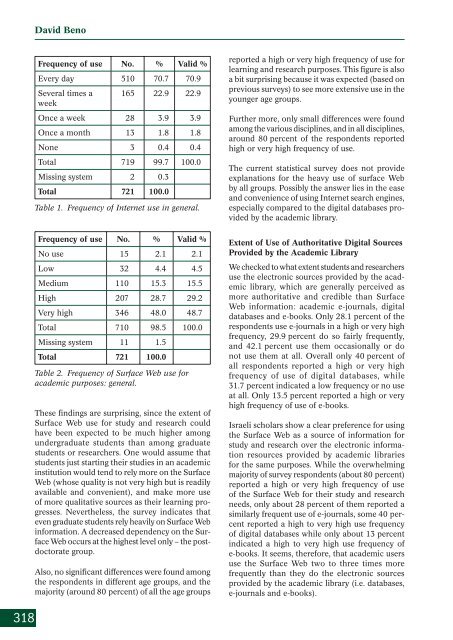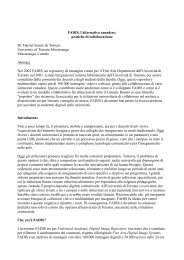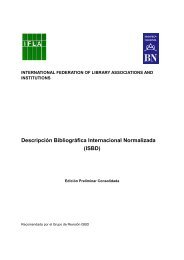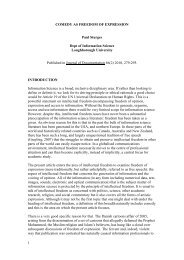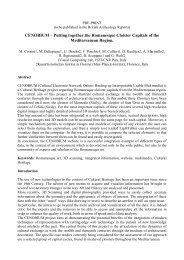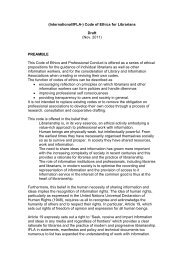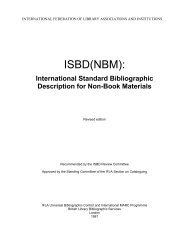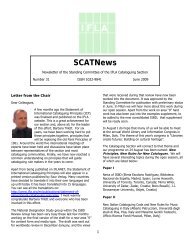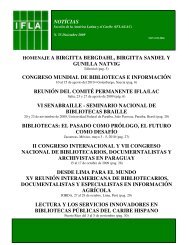World Library and Information Congress, Milan, 2009 - IFLA
World Library and Information Congress, Milan, 2009 - IFLA
World Library and Information Congress, Milan, 2009 - IFLA
You also want an ePaper? Increase the reach of your titles
YUMPU automatically turns print PDFs into web optimized ePapers that Google loves.
318<br />
David Beno<br />
Frequency of use No. % Valid %<br />
Every day 510 70.7 70.9<br />
Several times a<br />
week<br />
165 22.9 22.9<br />
Once a week 28 3.9 3.9<br />
Once a month 13 1.8 1.8<br />
None 3 0.4 0.4<br />
Total 719 99.7 100.0<br />
Missing system 2 0.3<br />
Total 721 100.0<br />
Table 1. Frequency of Internet use in general.<br />
Frequency of use No. % Valid %<br />
No use 15 2.1 2.1<br />
Low 32 4.4 4.5<br />
Medium 110 15.3 15.5<br />
High 207 28.7 29.2<br />
Very high 346 48.0 48.7<br />
Total 710 98.5 100.0<br />
Missing system 11 1.5<br />
Total 721 100.0<br />
Table 2. Frequency of Surface Web use for<br />
academic purposes: general.<br />
These fi ndings are surprising, since the extent of<br />
Surface Web use for study <strong>and</strong> research could<br />
have been expected to be much higher among<br />
undergraduate students than among graduate<br />
students or researchers. One would assume that<br />
students just starting their studies in an academic<br />
institution would tend to rely more on the Surface<br />
Web (whose quality is not very high but is readily<br />
available <strong>and</strong> convenient), <strong>and</strong> make more use<br />
of more qualitative sources as their learning progresses.<br />
Nevertheless, the survey indicates that<br />
even graduate students rely heavily on Surface Web<br />
information. A decreased dependency on the Surface<br />
Web occurs at the highest level only – the postdoctorate<br />
group.<br />
Also, no signifi cant differences were found among<br />
the respondents in different age groups, <strong>and</strong> the<br />
majority (around 80 percent) of all the age groups<br />
reported a high or very high frequency of use for<br />
learning <strong>and</strong> research purposes. This fi gure is also<br />
a bit surprising because it was expected (based on<br />
previous surveys) to see more extensive use in the<br />
younger age groups.<br />
Further more, only small differences were found<br />
among the various disciplines, <strong>and</strong> in all disciplines,<br />
around 80 percent of the respondents reported<br />
high or very high frequency of use.<br />
The current statistical survey does not provide<br />
explanations for the heavy use of surface Web<br />
by all groups. Possibly the answer lies in the ease<br />
<strong>and</strong> convenience of using Internet search engines,<br />
especially compared to the digital databases provided<br />
by the academic library.<br />
Extent of Use of Authoritative Digital Sources<br />
Provided by the Academic <strong>Library</strong><br />
We checked to what extent students <strong>and</strong> researchers<br />
use the electronic sources provided by the academic<br />
library, which are generally perceived as<br />
more authoritative <strong>and</strong> credible than Surface<br />
Web information: academic e-journals, digital<br />
databases <strong>and</strong> e-books. Only 28.1 percent of the<br />
respondents use e-journals in a high or very high<br />
frequency, 29.9 percent do so fairly frequently,<br />
<strong>and</strong> 42.1 percent use them occasionally or do<br />
not use them at all. Overall only 40 percent of<br />
all respondents reported a high or very high<br />
frequency of use of digital databases, while<br />
31.7 percent indicated a low frequency or no use<br />
at all. Only 13.5 percent reported a high or very<br />
high frequency of use of e-books.<br />
Israeli scholars show a clear preference for using<br />
the Surface Web as a source of information for<br />
study <strong>and</strong> research over the electronic information<br />
resources provided by academic libraries<br />
for the same purposes. While the overwhelming<br />
majority of survey respondents (about 80 percent)<br />
reported a high or very high frequency of use<br />
of the Surface Web for their study <strong>and</strong> research<br />
needs, only about 28 percent of them reported a<br />
similarly frequent use of e-journals, some 40 percent<br />
reported a high to very high use frequency<br />
of digital databases while only about 13 percent<br />
indicated a high to very high use frequency of<br />
e-books. It seems, therefore, that academic users<br />
use the Surface Web two to three times more<br />
frequently than they do the electronic sources<br />
provided by the academic library (i.e. databases,<br />
e-journals <strong>and</strong> e-books).


